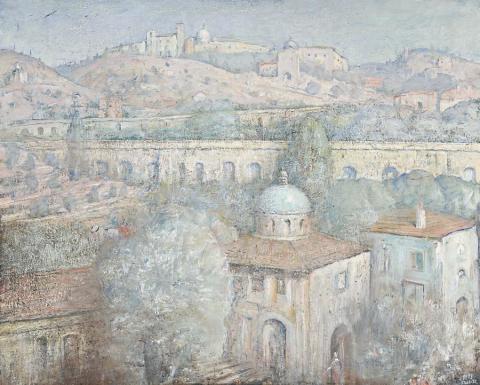TUSCANY, 1957/63/72
LLOYD REES
oil on canvas
86.5 x 108.0 cm
signed and dated lower right: L. Rees / 57-63-72
Artarmon Galleries, Sydney (label attached verso)
Dr and Mrs N. Behan, Brisbane
Christie's, Melbourne, 6 May 2003, lot 37
Private collection, New South Wales
Paintings and Drawings by Lloyd Rees, Johnstone Gallery, Brisbane, 3–18 September 1963, cat. 19, as 'Tuscany' 1963
Free, R., Lloyd Rees, Lansdowne Press, Sydney, 1979, cat. O227
Lloyd Rees had an abiding love of Italy, especially Tuscany in the north with its ancient cities and towns of Florence, San Gimignano and Arrezo. Birthplace of the Renaissance, fabulously rich in history, and even richer in art, of noble landscapes terraced with vineyards and olive groves, crowned by the grandeur of its architecture - all bear witness to countless years of human presence. Rees wrote of 'the living nature of its history', recalled in many paintings, especially the panoramic Tuscany 1957/63/72.1 Although inspired by the view from San Gimignano during a visit in 1953, it is not confined to the representation of a specific place as in the Art Gallery of South Australia's related painting San Gimignano 1953. Tuscany is a composite reminiscence of captivating beauty summarizing Rees's feelings for Italy. Reality, imagination and passion are equally blended, enveloped in the gentlest of light, giving form to the walled towns and buildings. Its embracing harmony is echoed in the domes, rounded arches, and rhythmical flow of the hills. This individuality of approach is found in companion paintings such as Afternoon in Tuscany c1953 and his Greek paintings of 1961.2 The Stones of Athens 1961 in the collection of the University of Queensland Art Museum is a fine example where architectural monuments again act as symbols of civilization and its flowering on the shores of the Mediterranean.
Rees and his wife often visited San Gimignano, the spellbinding medieval hilltop Tuscan town of ancient towers. Numerous drawings bear witness to the attraction of the region as seen in Tuscan Landscape, Italy, 1954 (Art Gallery of Western Australia), and The Ramparts of San Gimignano 1973 (The University of Sydney). Tuscany 1957/63/72, Rees wrote, 'would have been seen and worked in the original drawing or watercolour from the terrace of the Pensioni [sic] in San Gimignano' when visiting in 1953.3 In later years Rees gave up painting large canvases out of doors, preferring the sketch or watercolour 'sometimes complete in themselves. These I have in sight when working in the studio on the oil painting, but mostly to give association with the subject and revive the feel of it. I never try to make the oil a transcript of the drawing - it must be an entirely separate creation.'4 The present oil painting was first worked on in the studio in 1957. Minor changes were made over the years. 'I would say that there wasn't any major changes at those later dates but I always felt that it was the proper thing to do to note any changes made at a later date.'5 The added greater breadth of technique gives the painting a renewed freedom.
1. Rees, L., The Small Treasures of a Lifetime, Ure Smith Pty Ltd, Sydney, 1969, p. 140
2. Deutscher and Hackett, Melbourne, 27 August 2008, lot 12
3. Rees, L., letter of 25 June 1984 to the current owner
4. Rees, L., The Small Treasures', op. cit., pp. 150-151
5. Rees, L., letter of 25 June 1984
DAVID THOMAS
